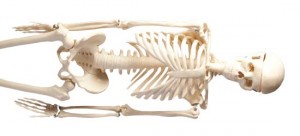
BONE DENSITY
Bone density is a medical term referring to the amount of matter there is in every cubic centimetre of bone. Bone density is used by doctors as an indirect indicator of osteoporosis and fracture risk.
Peak bone mass refers to the genetic potential for bone density. By the age of 20, the average woman has acquired most of her skeletal mass, but peak bone mass is achieved between 18 and 25. A large decline in bone mass occurs in older adults, increasing the risk of osteoporosis. For women this occurs around the time of menopause.
It is important for young girls to reach their peak bone mass in order to maintain bone health throughout life. A person with high bone mass as a young adult will be more likely to have a higher bone mass later in life.
OSTEOPOROSIS
Osteoporosis or “porous bone” is a disease of the skeletal system characterised by low bone mass and deterioration of bone tissue. Osteoporosis leads to an increased risk of fractures, typically in the wrist, hip, and spine.
While men and women of all ages and ethnicities can develop osteoporosis, some of the risk factors for osteoporosis include being a woman, especially a post menopausal woman, being older, being small in body size, eating a diet low in calcium and being physically inactive.
LIVING TISSUE
Bone is a living and growing tissue. Throughout life, bone is constantly being renewed in a process called remodelling. During remodelling, old bone is removed and is replaced with fresh new bone. Bone loss occurs when more bone is removed than replaced.
Maintaining healthy bones can be obtained by eating a well-balanced diet rich in calcium and vitamin D, participating in regular exercise, taking safety precautions to protect your bones and prevent falls, limiting alcohol intake, maintaining normal hormonal balance in premenopausal women, avoiding excessive dieting and excessive thinness and stopping smoking.
EXERCISE
Exercise that offers resistance and strength against gravity adds to bone strength. These activities are when your body’s movements are resisting gravity specifically. They include free weights, elastic exercise bands, weight machines in the gym and functional movements, such as standing and rising up on your toes or running in place. Yoga and Pilates are also great for resistance and strength exercise
Other weight-bearing impact exercises include dancing, hiking, rock climbing, jogging, jumping rope and stair-step, as well as sports, such as tennis.
Walking is also great. as are other weight-bearing low-impact exercises such as stair-step machines, elliptical training machines and walking on treadmills or outdoors.
CALCIUM
You can promote strong, healthy bones by eating enough calcium. About 99 per cent of your calcium is stored in bones and teeth, the other 1 per cent circulates in the body, helping important functions like muscle contractions and blood clotting. If your diet is low in calcium, your body draws the mineral from your bones, which, over time, can make them brittle.
Good sources of calcium to add to your diet include dairy products – low fat or non-fat milk (but full-cream milk for kids up to the age of two), cheese, and yoghurt, dark green leafy vegetables (such as bok choy and broccoli) – and calcium-fortified foods, such as cereal, orange juice, bread, soy beverages, and tofu products and almonds.
VITAMIN D
Don’t forget you need vitamin D, too, which helps the body absorb calcium. You can get it from fortified dairy products, egg yolks, salmon and tuna, as well as getting out in the sunshine.
Other research suggests that fruits and vegetables rich in potassium, magnesium and vitamin K may also be important for healthy bones.
Comments are closed.